How To Make Rosin For Bull Riding
Equally string players we all use rosin, merely how many of us understand its properties well plenty to choose the type that'due south right for us? Laurinel Owen investigates
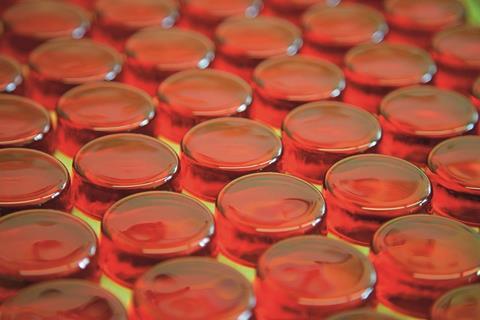
What is the first thing you do when you get your bow back from a rehair? Ever tried playing without showtime applying rosin? Nothing, cypher, nix. Even a beginner equally young equally iv is taught to rosin the bow. We all carry a picayune cake of the stuff in our cases only perhaps have scant thought about what it is and how information technology works. If we don't care and only desire to find the 'best' one, even a cursory wait online reveals an overwhelming choice: pupil, professional, nighttime, light, shocking pink (!), violin/viola, cello, bass, viola d'amore, constructed, in a box, on a cloth, golden, silver, shooting star iron and so on. Help! Check out prices and stride deeper into the quagmire: 68 pence (free shipping?) to one hundred times more. Let's hear what the experts have to say.
WHAT IS ROSIN?
An culling word for rosin, 'colophony', comes from the name of an ancient city, Colophon, in Asia Pocket-size nigh Ephesus (now present-day Turkey). It can also be known as 'Greek pitch' and comes in three varieties: 'gum', which is harvested from living pine copse; 'wood', from pine stumps; and 'tall oil', a past-product of paper lurid product. Apart from its employ on instrument bows, rosin is a common ingredient found in inks, newspaper, varnishes, glues, soap, cosmetics and myriad other products, and is a common allergen. Its frictional properties play an important role in calculation grip to the shoes of ballet, flamenco and Irish gaelic dancers, fencers, gymnasts, acrobats, baseball game pitchers and even balderdash riders needing extra contact with the rope.
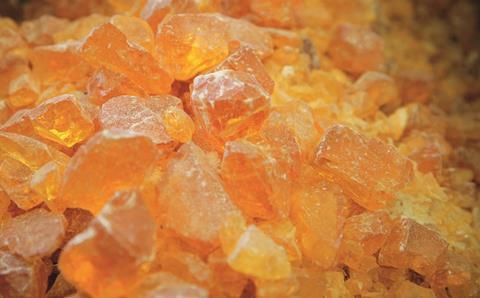
Pine sap (resin) is collected in a fashion like to the methods used in New England for harvesting maple syrup. A machete, hatchet or axe is used to score the bark of the tree and a collection bucket is positioned under the exposed sapwood for the resin to drain into. The raw ingredient is then heated to boiling to distil out the turpentine, then heated and cleaned further to dissever out the solids. This produces a pure substance that when cooled becomes hard and breakable at room temperature.
Fifty years ago, the largest tree plantations in the world were in the due south-east United States, merely because the process of collecting the resin became so labour-intensive, countries such as Red china and those in South and Fundamental America have go bigger players. Traditionally, in Europe the larch tree was used, whereas in the US it was pinus elliottii, known equally 'slash pine' because it grows and then chop-chop.
It is possible to use pure refined rosin on our bows, but producers and players accept constitute that with the addition of other ingredients, both the playability and sound quality are improved, every bit is the ease of application. However, each producer guards their 'underground' recipe.
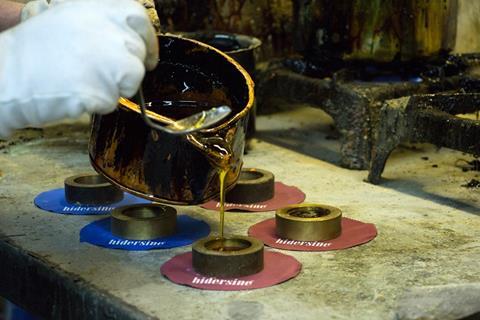
HOW DOES ROSIN WORK?
Equally children we were taught how to rosin our bows: scrape the block up and down the ribbon of hair. In our enthusiasm (and possibly to avoid spending time practising our scales) we rub the hair: 'I'm practising, mum.' When the bow finally touches the string, grit flies, caking the strings and varnish. We are oblivious to how the rosin interacts with the string to actuate the vibration.
'Rosin heats upwardly quickly with friction, peculiarly at room temperature and higher up,' says Fan-Chia Tao, the R&D director at D'Addario in New York. Nosotros are standing in front of two heat-controlled electric kettles set at 140C where the house's Kaplan brand rosin is cooking. 'The cord sticks to the rosin, which sticks to the bow hair. The contact at the beginning of the stroke sets up the string vibration and we have a response known every bit Helmholtz motion.' This is a stick-and-skid movement involving a spinning, twirling and snapping-back activeness produced past the ribbon of bow pilus as it grabs, releases and re-grabs the string. The process is much likewise quick for our eyes to perceive, but has been documented with very high-speed video cameras that can and so replay the footage at very deadening speeds.
The thickness of the string and skill of the player volition crave various amounts of stickiness in the rosin. This is where our choice comes into play. Basically, less stickiness/grip for a thin-stringed violin or viola and greater stickiness for cello and bass – easy to say just not so piece of cake to quantify. We'll come across that this is a subjective exercise.
The thickness of the string and the skill of the player will require various amounts of stickiness in the rosin
INGREDIENTS
The manufacturers of colophony rely on unlike sources for the pine sap, which is the predominant ingredient. In Dornach, Switzerland, Lothar Seitz makes the Larica brand colophony from the original German 'Liebenzeller' recipe. The raw sap that he imports from a tree farmer in Austria is milky-white, yellowish or even reddish. He doesn't know why at that place is a deviation in color from i tree to some other. The bigger producers larn the resin from chemical companies, which come in chips or blocks already bleached and cooked to remove the particles and granules.
With a scrap of prodding I am able to detect some of the extra ingredients that manufacturers add together to the basic colophonia resina: a variety of waxes, calcium and specialist oils. Several products include metals such as gold, silver, copper, tin and even meteorite dust.
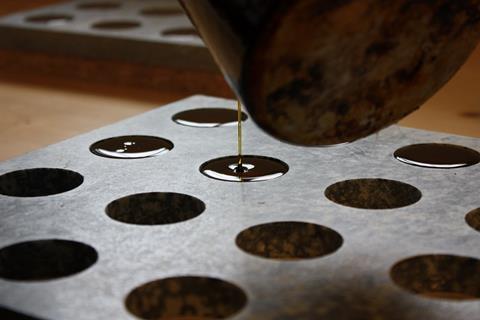
HOW IS ROSIN Made?
Barnes & Mullins, based in Shropshire, Great britain, articles Hidersine, Birch's 'AB' and W.Due east. Hill & Sons rosins. Articulation managing manager Bruce Perrin describes how he learnt the craft at the get-go of his career:
'Information technology was my job to travel every 24-hour interval from central London down to Shirley in south London to learn the art of transforming resin into rosin. At the fourth dimension, the whole process was overcast with mystery and intrigue. I discovered that i man, "Jock" Smith, a rather scary Scotsman, was the tutor working in what was no bigger than a small garage – a very confined place that got smokier and smokier as the morning went on.
'My showtime job each twenty-four hour period would be to mix the required ingredients in a big copper urn, which I'd place on a gas-fired ring and carefully bring the contents upwardly to the optimum temperature. While this was heating I would lay the rosin cloths on a big marble tabular array, and so position brass moulds in the center of each fabric. [The reason for the marble table and brass moulds is to dissipate oestrus quickly.] The moulds were tapered then they were easy to remove once cooled, simply had to exist kept very clean. Past the time this procedure was complete, the rosin was at the required temperature.
'From the big urn I poured the rosin into a copper jug and from there parcelled the molten liquid evenly into the moulds, producing a dozen at a time. After each twelve, I "flamed" over the surface of each mould to remove any air bubbling, which left the top of each rosin cake perfectly smooth. Past the time the last mould was filled, the rosin at the beginning of the serial had set and could be removed from the marble tabular array set up to box. So I'd begin the wheel all over once more for the entire solar day. I must say it was very therapeutic!'
'You can't rely on colour. It'southward basically psychological. Information technology's like saying that all ruby-red cars go faster' – Fan-Chia Tao
PROPERTIES
Wolfgang Weiss, manager of sales at Thomastik-Infeld, speaks to me from Vienna where the company makes 14 different types of rosin. 'Each rosin reflects different grades of stickiness, which depend on the properties of each tree and our other oils and additives. Stickier, softer rosin has a slower response and more bow noise than harder rosin. In a very dry climate the actor may demand more grip than in a humid environment. Moisture and high temperature make rosin pasty. Also, the musician's playing style will determine the preference.'
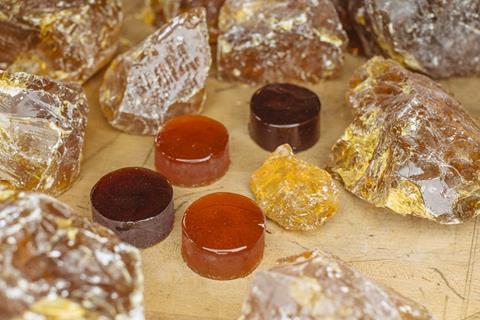
'Some players utilize lighter rosin in summer or more humid climates, and dark rosin in winter,' reports Rachel Drehmann, who prepares the rosin for Salchow & Sons bow makers in New York Metropolis. 'It is upwardly to the thespian to experiment with what works best. William Salchow started making rosin more 50 years ago and we've kept the recipe the same. Our rosin is a home-made product; nosotros keep it simple and make information technology to society. When weighing in, I tin can say that nosotros sell more dark than light.'
The German cord company Pirastro markets twelve rosins. 'Each production was developed to friction match our strings,' says technical managing director Adrian Müller. 'The central question is whether you like difficult or soft. Colour does non come into it.'
D'Addario's Fan-Chia Tao concurs: 'You can't rely on colour. Colour is basically psychological. Information technology is similar maxim that all red cars get faster. This is non an indication of grip. Players often think that sticky is ameliorate. Yes, at the offset of the stroke. Withal, sticky does not give you every bit big a tonal palette. You lose dash. Beginners need sticky, simply advanced players should be able to command the bow with a finer course.'
What about the deject of dust, about like fume, that rises from a newly rosined bow? Bruce Perrin claims: 'The amount of dust will depend on the quality of the bow hair; coarse hair will produce more grit. Applying too much rosin will clog the natural barbs of the bow pilus and cause the rosin to drop from the pilus on to the instrument.' The overall communication appears to exist: don't use besides much. Less is more.
There seems to be controversy concerning the topic of metal added to rosin. As 1 would expect, those producers who add gold claim that the tone will exist more than counterbalanced, full, harmonious, round, warm, large, bright and articulate and that metal allows better contact between the rosin and the string. The others say that metal could be detrimental to the strings and bow hair. 'Smoke and mirrors' is i annotate I hear.
CONCLUSIONS
With the dozens (or hundreds) of rosins on the market, how are we to choose? 'Players must consider carefully what sound and response characteristics they wish to enhance, rather than simply looking for something that might just be a welcome modify from their current rosin,' says Andrew Bakery of Australian business firm Leatherwood Bespoke Rosin. 'And in response, rosin makers should exist able to qualify and communicate clearly the specific audio and response characteristics their rosins provide.'
Price is not an accurate guide to quality, considering much of the cost can be in the packaging and ad. I have several rosins that are housed in cute olivewood boxes and fifty-fifty violin-shaped wooden boxes with the lids held in place with magnets. They await beautiful and the rosin is excellent, but I know I paid by and large for the box.
I've played the cello for decades, yet in researching this article, this one-time dog learnt a couple of new tricks. 'In very cold and very hot climates,' comments Perrin, 'it is of import to protect the rosin from extremes of temperature. When not being used it is advisable to go along the rosin in the musical instrument case.'
And Pirastro'due south Müller caps our discussion with these final words: 'After two years or so, rosin gets hard and brittle. It'll crack and won't have the aforementioned characteristics as when it'southward new. The chemical composition changes. Nosotros've been asked to postage due dates on our rosin, but information technology just isn't practical.'
On that notation, I'm going to throw away my erstwhile cake and start shopping.
Source: https://www.thestrad.com/improve-your-playing/sticky-stuff-how-rosin-is-made-and-how-to-choose-the-right-one-for-your-needs/7253.article

0 Response to "How To Make Rosin For Bull Riding"
Post a Comment